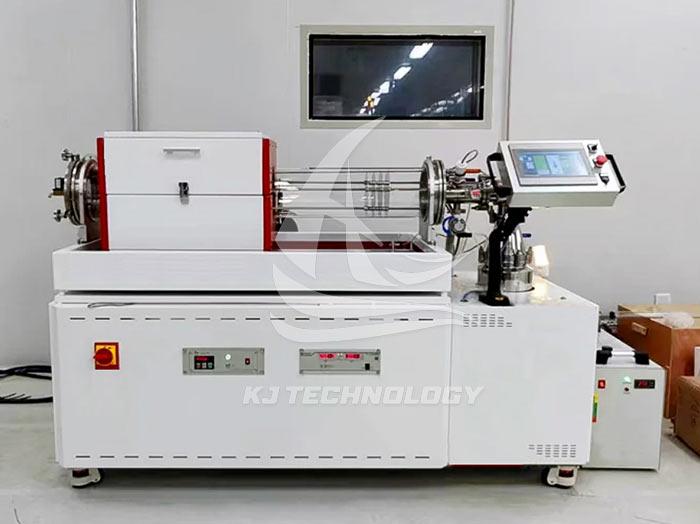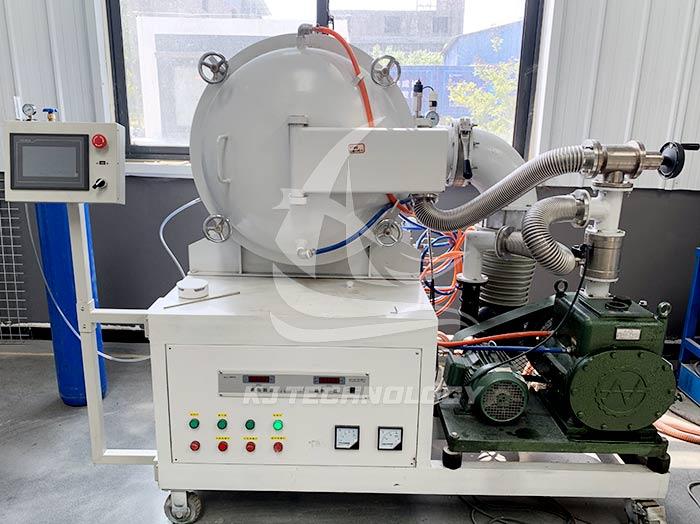Daily maintenance of laboratory graphite vacuum furnace
 08-06-2025 Author: KJ technology
08-06-2025 Author: KJ technology
The daily maintenance of laboratory graphite vacuum furnaces is a key link to ensure stable operation of equipment, extend service life, and ensure the accuracy of experimental results. We provide a systematic maintenance plan from the aspects of cleaning and maintenance, vacuum system maintenance, heating system maintenance, temperature control system inspection, mechanical structure maintenance, safety protection, and record management.
1. Cleaning and maintenance
Internal cleaning of furnace body
Frequency: After each experiment or every 24 hours of continuous operation.
method:
Use a soft bristled brush or vacuum cleaner to remove residual powder and particles from the furnace, and avoid using hard tools to scrape the graphite inner wall.
For stubborn stains, anhydrous ethanol or acetone can be used for wiping, but it is necessary to ensure complete evaporation before using electricity.
Attention: Wear dust masks and gloves during cleaning to avoid inhaling graphite dust or coming into contact with chemical solvents.
Observation window cleaning
Frequency: Once a week.
Method: Wipe the observation window with a specialized glass cleaner to ensure no oil stains, fingerprints, or scratches, and maintain a clear view.
External surface cleaning
Frequency: once a day.
Method: Wipe the furnace shell with a dry cloth, avoid using corrosive cleaning agents, and prevent damage to the surface coating.
2. Vacuum system maintenance
Vacuum pump maintenance
Oil level check: Check the pump oil level before daily operation to ensure it is between the oil gauge marks. If the oil level is too low, it is necessary to replenish the same model of vacuum pump oil.
Oil quality replacement: Replace with new oil every 200 hours of operation or when the oil quality turns black or cloudy. When replacing, it is necessary to drain the old oil, clean the oil chamber, and then inject new oil.
Cleaning of air intake filter: Check and clean the filter every week to prevent dust from blocking and affecting the air extraction efficiency.
Seal inspection
Frequency: Once a month.
method:
Check whether the sealing rings of the furnace door, flange, observation window and other parts are aging, deformed or cracked.
Apply soapy water to the sealing surface and observe for any bubbles to confirm the sealing performance.
Replacement standard: If the sealing ring has cracks or a compression permanent deformation rate exceeding 30%, it should be replaced in a timely manner.
Vacuum pipeline inspection
Frequency: Once every quarter.
Method: Check if the pipeline connections are loose or leaking, and use a helium mass spectrometer leak detector to detect minor leaks.
Solution: Re tighten or replace the sealing components of the leaking parts, and replace the aging pipelines if necessary.
3. Heating system maintenance
Heating element inspection
Frequency: Once a month.
method:
Visually inspect whether the graphite heating rod and heating wire are broken, oxidized, or deformed.
Measure the resistance value of the heating element with a multimeter and compare it with the nominal value. If the deviation exceeds 10%, it needs to be replaced.
Attention: When replacing the heating element, the power should be turned off to avoid the risk of electric shock.
Tightening of electrode connection
Frequency: Once every quarter.
Method: Check if the connecting bolts between the electrode and the heating element are loose, tighten them to the specified torque with a wrench, and prevent local overheating caused by increased contact resistance.
Graphite protection
method:
Avoid direct contact with metal tools to prevent scratching the surface of graphite.
When not in use for a long time, apply an anti-oxidation coating (such as boric acid solution) on the surface of graphite parts to reduce oxidation losses.
4. Temperature control system inspection
Thermocouple calibration
Frequency: Once every six months.
Method: Compare the thermocouple with a standard thermometer and calibrate it at key temperature points such as 100 ℃, 300 ℃, and 500 ℃. If the deviation exceeds ± 2 ℃, it needs to be adjusted or replaced.
Temperature controller parameter verification
Frequency: Once a month.
Method: Check whether the PID parameters (proportional, integral, derivative) set by the thermostat are consistent with the equipment requirements to avoid excessive temperature fluctuations.
Signal line inspection
Frequency: Once every quarter.
Method: Check whether the signal wires between the thermocouple and the temperature controller are damaged or loose, to ensure stable signal transmission.
5. Mechanical structure maintenance
Lubrication of furnace door hinge
Frequency: Once a month.
Method: Apply high-temperature grease (such as molybdenum disulfide grease) to the hinge to reduce wear and abnormal noise.
Fan maintenance
Frequency: Once every quarter.
method:
Clean the dust on the fan blades to prevent overheating caused by poor airflow.
Check if the fan bearings are short of oil and add lubricating oil to the specified level.
Inspection of transmission components
Frequency: Once every six months.
Method: Check whether the transmission components such as the furnace door lifting mechanism and the material tray moving device are flexible, and adjust the tightness of the belt or chain to the specified range.
6. Security protection
Grounding inspection
Frequency: Once a month.
Method: Use a grounding resistance tester to measure the grounding resistance of the equipment, ensuring it is ≤ 4 Ω to prevent the risk of leakage.
Emergency stop button test
Frequency: Once every quarter.
Method: Press the emergency stop button and confirm that the device can immediately stop running. After resetting, the function will be normal.
Inspection of protective devices
Frequency: Before daily operation.
Method: Check whether the furnace door safety interlock device and over temperature alarm device are sensitive and reliable to ensure the safety of the experiment.
7. Record management
Maintenance log
Content: Record the time, items, replaced parts, and operator information for each maintenance.
Function: To provide historical data support for equipment maintenance, facilitating the tracking of fault causes and optimizing maintenance plans.
Fault file
Content: Record equipment malfunction symptoms, maintenance process, and replaced parts.
Function: Analyze fault patterns and prevent similar problems from occurring in advance.








